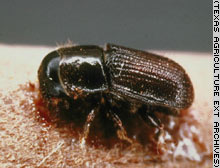Researchers were able to diagnose, using X-rays, a lung-like structure in the insects' bodies. These, it turns out, actively exhale and inhale, just like us. This ended a debate that started back in Aristotle's time

Insects, it is commonly assumed, do not have lungs, so how do they breathe? Apparently their breathing process is more efficient than that of humans. This is evident from a first close look at the tiny oxygen tubes in insects - those tiny creatures that we thought every detail of has been known to science for hundreds of years.
Exposing insects to X-rays a billion times stronger than those used by doctors, settling an age-old debate in science: insects, it turns out, do indeed breathe.
The discovery may seem small, and in some ways it is. The lung-like structure that the scientists were able to diagnose using the X-rays is smaller than the punctuation mark in this sentence.
But for biologists, the evidence that insects actively exhale and inhale is nothing less than historical. This ends a debate that started back in the time of Aristotle, who believed that insects do live but cannot breathe. "We can see the canals in the bodies of the insects that actually contract and release," said Mark Westnit of the Science Museum in Chicago, who led the study.
This is the first study in which high energy is used to produce a video recording the biological process. "It is not a lung, but a lung-like organ," Westnit added.
Until the last decades, biologists agreed with Aristotle's view that air simply enters and leaves small spaces in the bodies of insects. Recently it became clear that the insects actively remove air from these spaces by moving their bodies in a certain way. However, it is only now becoming clear that insects - just like humans - make use of muscles specifically designed for inhaling and exhaling.
The machine in which they performed the experiment is called a synchrotron, a large particle accelerator where the most powerful X-rays in the world are created. There are only a few such devices in the world, used mainly in the chemical industry.
Physicist Wah-Kit Lee, who usually studies argon gas, came up with the possibility of using it to examine a dead insect. He placed such an insect on the synchrotron and examined the details of the image in which the insect's limbs are photographed in detail. Together with Westnit he placed live insects in the machine. They bombarded them with tens of millions of doses of radiation, so it is impossible to conduct this experiment with clearly more developed life.

3 תגובות
exciting!!!
So...he breathes like us? suffix?
I didn't understand how insects breathe